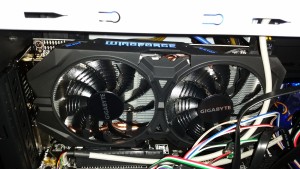I got the Gigabyte R9 380 4GB graphics card in the mail last Friday. The box was pretty slim and didn’t contain anything other than packing material, a quick install guide, and the card. I kind of thought there would be a disc with some Gigabyte utilities, but nope. I installed the card in the desktop with no problem. See the picture below. The “Windforce” text lights up blue when the fans come on and that’s pretty cool and fits with the blue LED fan in the front of the case.
The only tricky part of the install was I didn’t uninstall the old AMD drivers, because I didn’t want to uninstall the A10-7850k’s graphics. I was hoping the Catalyst utility would have detected the new card and prompted an update, or even Windows, but both seem satisfied that the A10-7850k was installed and didn’t care about the new card that was currently running everything. So, I went to AMD’s website and manually selected the drivers and installed them.
For the price, it really is a powerful and relatively low power card. It kept prompting me to run Windows with Virtual Super Resolution turned on, but I passed. I made a few more tweaks, like capping the FPS at 60 with Frame Rate Targeting and adjusting the desktop size to get it to fit on my TV screen properly.
As far as gaming, I tried several different games, but I don’t have a benchmarking tool and the most graphically strenuous game I have is either Alien Isolation or Civilization Beyond Earth. I ran Alien at 1080p with everything I could turn up to max up to max. It looked great, but I think the character model teeth, lips, and tongues could have used some more work. And there is so much dust floating around in the air! Do none of these spaceships or space stations have dust filters on the air intakes?
Civilization Beyond Earth doesn’t look much better than when I run it on my other desktop with an old Radeon 6850, but I also didn’t play more than a few minutes. There was a lot of screen tearing whenever I panned map, too. I suspect I need to play around more with the frame rate targeting, vsync, and my TVs refresh rate.
To sum up, it’s a great card. It’s quiet, seems to run cool, has some nice power saving features, and can max out any game I currently own. If the price on this card creeps down with a holiday sale or the release of a 380x, it’ll totally be worth picking up. There are plenty of benchmarks out there now if you want to see some hard numbers.
As far as the card being bottlenecked by the APU, I haven’t experienced it, yet. And I’m not sure I would know if it did happen. With Windows 10 dropping soon, I suspect if the problem does it exist, it will be mitigated somewhat by DX12.
After installing the card, I felt the need to do a little celebrating. Below is an 18% ABV stout by Mikkeller that I got on sale at my usual pirate-themed haunt. I think it’s just called “Black,” but the site seems to indicate it’s called “Black Fist.”
Whatever it’s actual name, it does hit hard up front and finishes a little bitter and smokey on the back. It’s not an every weekend beer. I’m not sure it’s even a once a year beer. Best just to split a bottle with a friend or three.
Since discovering Hitachino Nest’s beers, I’ve been working through their offerings as I’m able. I got to try XH and didn’t want to pass up the chance, despite putting down the above mentioned monster. While I love me some sake, this one just didn’t measure up to my expectations. I could catch a hint of the sake–the dryness of it–but not much. Just stick with the Red Rice Ale.
Closing this one with a shout out. Check out Dirty Coast. It’s a locally-owned clothing and art store in New Orleans. They have some pretty neat stuff and also sometimes run events to benefit local charities. Check out their website or visit one of their stores in the Crescent City.




